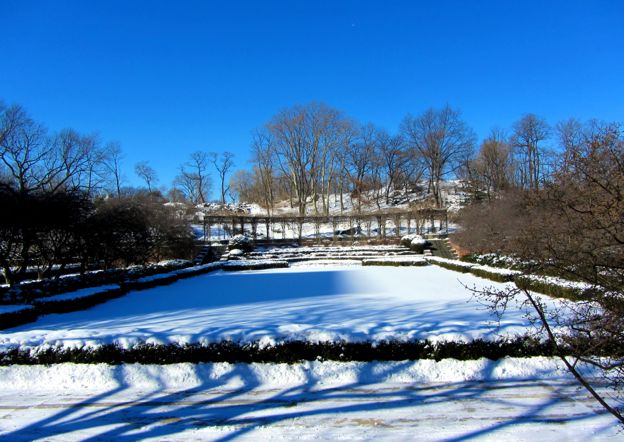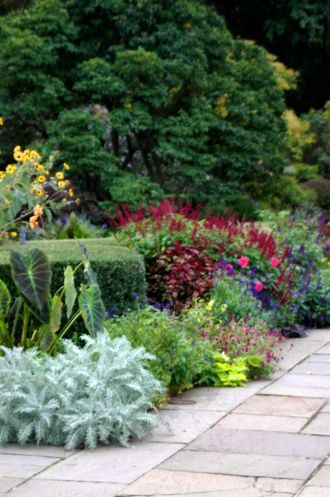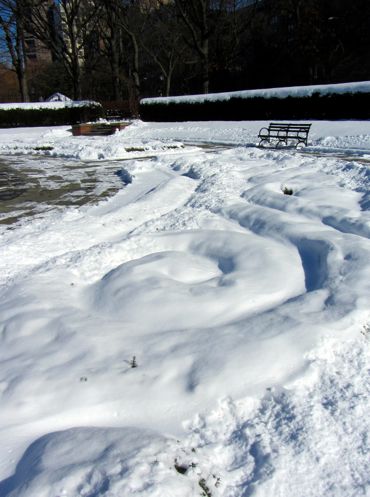Not An Armchair Gardener

Winter is the season that separates real gardeners from garden dabblers and real garden lovers from armchair garden admirers.
Real gardeners are the ones who, when December seed, plant, and tool catalogues cascade through the mail slot, display strong preferences about vendors and make well-conceived plans. They have a certain smug gardeners’ “savoir faire”.
Not so me. I am a garden dabbler. A B- gardener. When I pick up a pair of pruners my shrubs and perennials quiver in trepidation.
On the other hand, I am a real garden lover. Sitting in a comfy armchair poring over catalogues and magazines, is fine as far as it goes, but I prefer to be in a garden, especially in winter, when it is easiest to embrace its silence, simplicity, and structure.

When the pile of garden catalogues and magazines reached a critical mass last week I was in New York and I resolved to revisit the Conservatory Garden, on the upper east side of Central Park. It was built by WPA workers in 1937 on the site of an old conservatory, and is the only formal garden in Olmstead and Vaux’s masterpiece.
A client took me to see it a few Septembers years ago just as summer’s glory was segueing into the abundance and looseness of fall. Summer colors clashed with emerging autumn colors, seed heads were forming, and the leaves on the trees were just beginning to drop. It was gorgeously distracting from the garden’s layout.
Not so last week in single digits and worse with wind chill. Snow lay on the ground. The paths were icily treacherous. The garden’s skeleton, the bare black branches of trees, the endless play of light and shade, and its winter silence was completely accessible. The scene was well worth braving polar conditions.
You enter the Conservatory Garden through the Vanderbilt Gate at East 104th Street in the center of the 6-acre garden. The entrance is at street level but a gracious wide staircase takes you down to garden level. Before you stretches a long, wide lawn flanked by clipped boxwood hedges and double allees of mature crabapples. At the far end a pair of long staircases on either side of the lawn lead you up to the enormous ironwork pergola smothered in almost ancient wisteria. The two gardens on either side of the lawn are obscured by the crabapple trees and include distinctive curvaceous walks, water features, and clipped shrubs. Their more intricate and complicated designs, each unique, contrasts with the simple, formal central space.
I walked down the broad steps and turned left toward the section where my client had shown me the profusion of flowers and colors that appealed to her. In the quiet of this sunny snowy January day, those colors had faded to green, white, and beige. Black benches provide accent and echoed the dark branches overhead. Patches of muted gray and brick hardscape peaked out from the snow underfoot. It was almost a different place.
A sudden blast of Arctic wind suggested that I was a little crazy. Who goes walking through gardens in a minus something wind chilled garden?

I came up with at least half a dozen reasons to do so.
First, in winter, whether cold or not, you can really see the way a garden flows – how one path leads to another, and how they interconnect with spaces, entries, and enclosures. Look at your own garden now and you can see the same thing.
Views become very important. In the Conservatory Garden, spring, summer, and fall foliage and profusion block out the city. In winter, the geometry of the buildings on Fifth Avenue becomes its backdrop and the inner geometry of the garden brilliantly reflects the strong vertical shapes of the buildings on the horizontal plane in a back and forth visual conversation. The relief of non-linear shapes – curved walks, bench details, the arch of the pergola, and the shapes of pruned hedges ease the harshness of the urban surroundings. If you are a gardener, real or dabbler, this is a good time to look at your own garden to determine what views you might want to integrate – or what you might want to block.

In the Conservatory Garden I found that the absence of leaves, children playing, dog walkers, flowers, and all the liveliness of other seasons leaves a minority of residual details that become all the more important: A robin eating frozen crimson berries; the icicle hanging from the iron work; the shadowy depressions in the snow on top of low clipped boxwood hedges that hint at the “parterre de broderie” beneath; the intricate strength and patterns of bark, branches and trunks inside and outside of the garden. A well-designed garden makes these details, fleeting or fixed, possible.
Winter light is different than the other seasons. Lower in the sky, the sun casts extra long tree shadows in perse patterns so unlike the gray, bulky shadows of trees in spring bud, in summer’s full leaf, or in the tattered partial leaflessness of fall.

And the details are much cleaner and tidier. There are no flowers that need deadheading, no overgrown annuals casually hanging in paths, no colors hot or cool. There is nothing to distract you from seeing the quality of stonework, the strength of layout, the relationship of vertical to horizontal structure – the elements some refer to as a garden’s “bones”. If a garden is well designed, it is a pleasure to look at it anytime of year.

Perhaps the best thing about walking through a garden in winter is the sense of being suspended between one moment and the next: The past isevidenced in the filigreed seed heads of long finished asters or the dried bracts of last summer’s hydrangeas. The future is anticipated in the frames of flowers supports awaiting the delicate stems of top-heavy peonies and the emerging pubescent buds of deciduous magnolias. The garden in winter reflects a time of peacefulness, clarity, nostalgia, and expectation.
One can breathe and reflect. But only if one gets out of the armchair.





